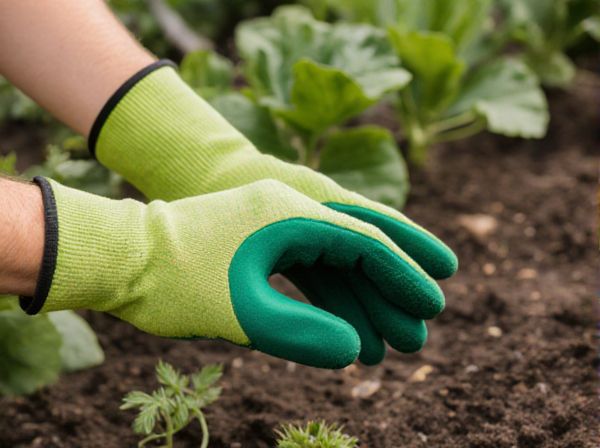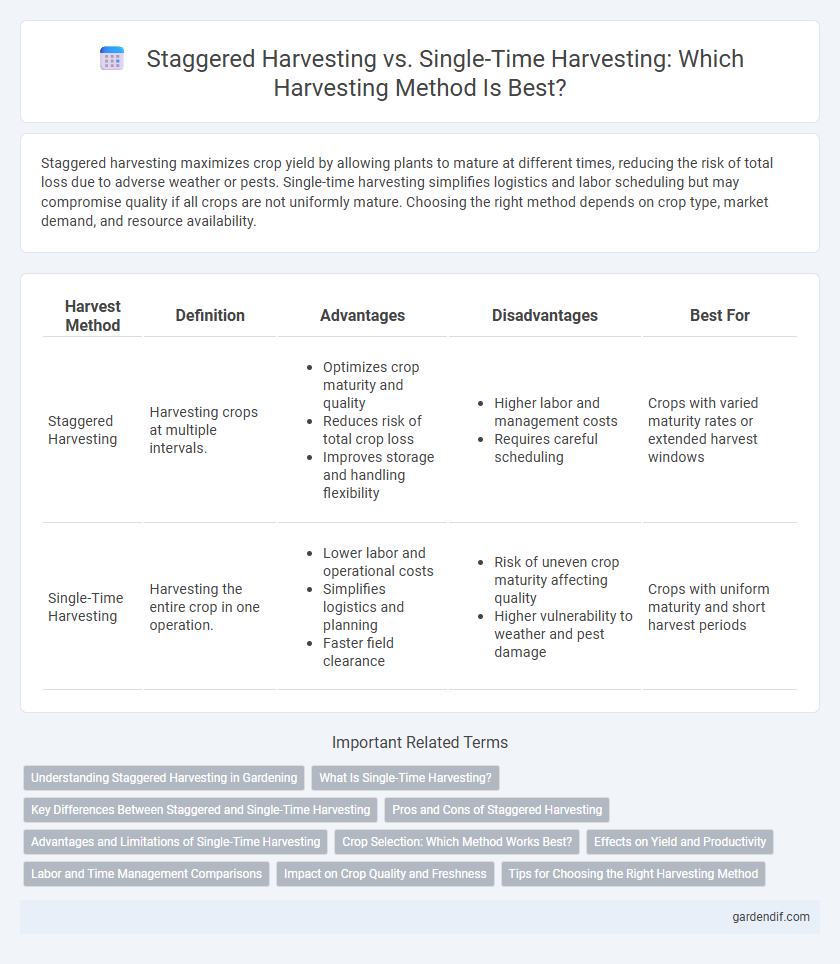
Staggered Harvesting vs Single-Time Harvesting Illustration
Staggered harvesting maximizes crop yield by allowing plants to mature at different times, reducing the risk of total loss due to adverse weather or pests. Single-time harvesting simplifies logistics and labor scheduling but may compromise quality if all crops are not uniformly mature. Choosing the right method depends on crop type, market demand, and resource availability.
Table of Comparison
| Harvest Method | Definition | Advantages | Disadvantages | Best For |
|---|---|---|---|---|
| Staggered Harvesting | Harvesting crops at multiple intervals. |
|
|
Crops with varied maturity rates or extended harvest windows |
| Single-Time Harvesting | Harvesting the entire crop in one operation. |
|
|
Crops with uniform maturity and short harvest periods |
Understanding Staggered Harvesting in Gardening
Staggered harvesting in gardening involves collecting crops at different times as they ripen, ensuring a continuous supply of fresh produce and reducing waste compared to single-time harvesting. This method improves crop yield by allowing plants to mature fully, optimizing nutrient content and flavor in each harvest batch. Implementing staggered harvesting enhances garden productivity and supports sustainable growing practices.
What Is Single-Time Harvesting?
Single-time harvesting involves collecting the entire crop in one event, maximizing efficiency and reducing labor costs compared to staggered harvesting. This method is common in crops with uniform maturity, such as wheat or barley, allowing for streamlined processing and storage. However, it may increase the risk of yield loss if weather conditions deteriorate unexpectedly during the harvest window.
Key Differences Between Staggered and Single-Time Harvesting
Staggered harvesting involves collecting crops in multiple phases based on varying maturity levels, which optimizes yield quality and reduces losses from overripe produce. Single-time harvesting gathers all crops simultaneously, often simplifying labor but risking uneven ripeness and potential quality degradation. The primary difference lies in timing and resource allocation, where staggered harvesting requires more management but enhances crop market value.
Pros and Cons of Staggered Harvesting
Staggered harvesting allows for multiple pickings over time, minimizing crop loss due to over-ripening and ensuring a more consistent market supply. This method improves labor efficiency by distributing workload and can extend product freshness, but it often requires more complex planning and increased labor costs compared to single-time harvesting. Smaller, repeated harvests can also reduce machinery wear and soil compaction, promoting sustainable farm practices.
Advantages and Limitations of Single-Time Harvesting
Single-time harvesting consolidates crop collection into one operation, reducing labor costs and simplifying logistics, which is particularly beneficial for small-scale farms or crops with uniform maturity. However, this method can lead to quality degradation and increased post-harvest losses if parts of the crop are immature or overripe at harvest time. The inflexibility of single-time harvesting limits the ability to optimize yield quality compared to staggered harvesting, which allows for selective picking based on crop readiness.
Crop Selection: Which Method Works Best?
Staggered harvesting is ideal for crops with varying maturity rates, such as tomatoes and peppers, allowing farmers to optimize yield and quality by picking fruits at their peak ripeness. Single-time harvesting suits uniform crops like wheat and barley, which mature simultaneously and streamline labor and processing. Crop selection plays a crucial role in determining the best harvesting method, impacting overall efficiency and market timing.
Effects on Yield and Productivity
Staggered harvesting enhances overall yield by allowing crops to mature at different times, reducing losses due to pests, weather, or over-ripening. This approach increases productivity by enabling continuous labor utilization and steady market supply, minimizing post-harvest waste. In contrast, single-time harvesting often results in lower total yield and productivity due to the risk of crop damage and logistical bottlenecks during peak harvesting periods.
Labor and Time Management Comparisons
Staggered harvesting optimizes labor allocation by spreading work demands over an extended period, reducing peak labor needs and minimizing worker fatigue. Single-time harvesting requires a large, concentrated workforce for a short duration, increasing labor costs and logistical challenges. Time management becomes more flexible with staggered harvesting, allowing better scheduling and resource utilization compared to the rigid timing of single-time harvesting.
Impact on Crop Quality and Freshness
Staggered harvesting enhances crop quality and freshness by allowing fruits and vegetables to ripen fully before picking, reducing the risk of spoilage and nutrient loss. Single-time harvesting often leads to varied maturity levels, resulting in inconsistent taste and texture within the batch. This method also increases the likelihood of damaged or overripe produce, negatively impacting overall market value.
Tips for Choosing the Right Harvesting Method
Choosing between staggered harvesting and single-time harvesting depends on crop type, market demand, and labor availability. Staggered harvesting optimizes yield by allowing crops to mature at different times, reducing spoilage and ensuring continuous supply, while single-time harvesting suits uniform crops and simplifies labor management. Evaluate factors such as crop perishability, resource allocation, and financial goals to select the most efficient harvesting strategy.
Staggered Harvesting vs Single-Time Harvesting Infographic

 gardendif.com
gardendif.com